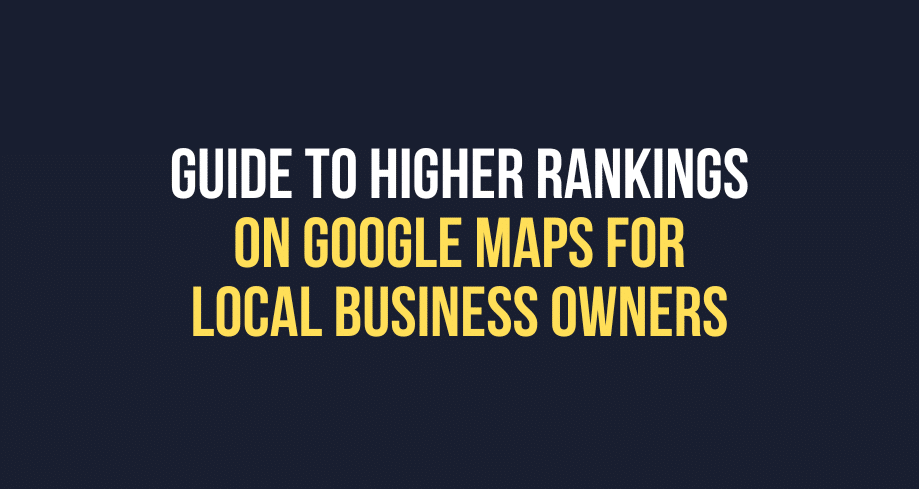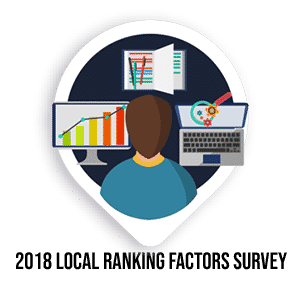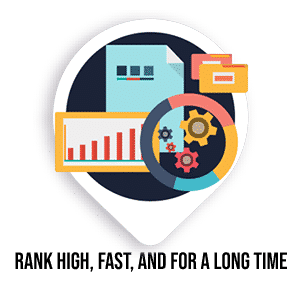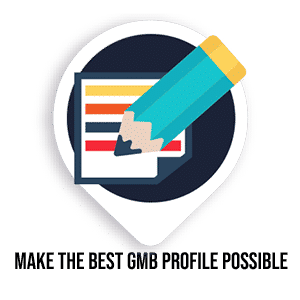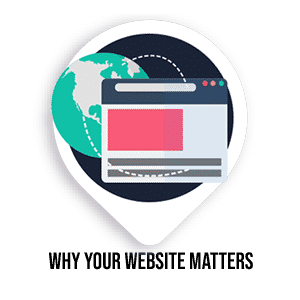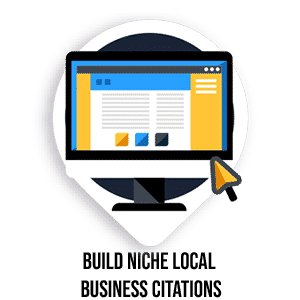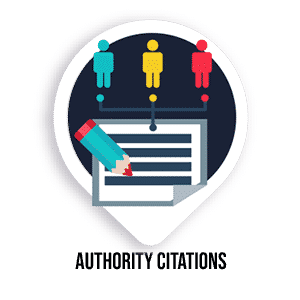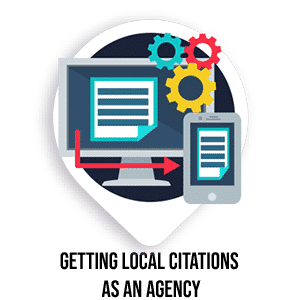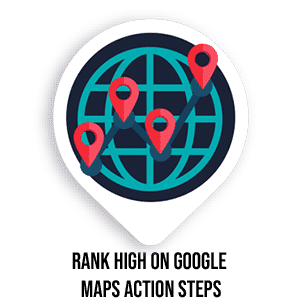WHO IS THIS GUIDE FOR:
I get it. You’re a local business owner who works 24/7. This is not what you had in mind when you decided to become an entrepreneur, am I right?
You’re all about the hands on. Making sure things run smoothly. Keeping your customers happy. If you can get them rushing through your doors that is.
And, maybe marketing your business online isn’t in your zone of genius, but you realize it’s important. Since your marketing moolah is likely already allocated and a bit tight like it is for most small businesses, it’s a big deal to know how to get your place ranked on Google Maps.
Why?
It would be great to save yourself a little money and not have to outsource the job to someone, wouldn’t it? Especially if your shoestring budget is about to snap.
Being at the top of Google Maps for your industry in your area means those peeps out driving around right now, searching for what you’ve got to offer – they see YOU first. That’s a strong way to get them lining up around the block waiting for your doors to open (or jamming your phone lines when you start taking calls for the day).
If nobody in your town knows you’re out there with a product or service to give them, you’re out of luck. And, since most people these days are actively searching Google for solutions to their problems (an empty belly, a leaky pipe, or whatever), they are prime to buy, and pronto!
Think about how often you say, “Hey Alexa,” when you need to call a plumber in a hurry, or “Hey Siri” when you’re in the car taking a lunch break and need good eats. Guess what results you hear and see when you do? Yep, Google Maps.
Why you want to get that top spot in Google Maps may vary. Usually it’s because you’ve been in business for awhile but don’t have the traction you want. Or, maybe you’ve recently changed locations and want your customers to be able to find you. Possibly, you’re brand spanking new to business and you’re looking for an inexpensive way to be found.
Heck, you may even be interested in being the one to provide this exact service to businesses in your local area for them as you build your own marketing agency. I’m cool with that motivation too!
Whatever your case is, I can give you the exact ways to rank your pretty little biz at the top of Google Maps in your area FAST. And, if you’re looking for the quick and painless way to do it, here’s my solution…
Read this guide.
It’s full of all the no nonsense stuff and none of the fluff I’ve used to help countless businesses just like yours to see their name in lights at the top of Google Maps. Plus, it’s a whole lot less expensive than having me do your agency work!
I promise you, anyone can do this successfully. Follow along and pull the trigger after each step. Just make sure you take action on each task because they wouldn’t be on the list if they didn’t matter.
So, I have one question for you. Are you ready for results like these?

If so, read on my friend.
WHY THIS GUIDE EXISTS:
Believe it or not, I was once new to agency work and digital marketing. When I started, I learned a little something about what to do because of the bunches of things I didn’t do right. Failure became my favorite professor. Whenever she showed up, I knew I’d have to figure out a different way to get from point A to point B than the path I was on.
I needed to figure out how to be seen and booked by the businesses I was attempting to attract. My goal was to be the one agency they knew they needed when they were ready to get serious about dominating their niche. Whether it would be today, tomorrow, or a year in the future, I wanted them to know I was their Huckleberry.
Call me Dr. Frankenstein and my digital marketing business the “monster”. Once I became known as the “dude”, it was game on to help other businesses become notorious. After I braved that frontier, it became natural to teach others how they could do this for themselves or for other businesses.
Because I dove deep to understand exactly how to get local businesses to rank in the top three on Google, I figured it was high time to get this guide into the hands of small business owners who really need it. Because, we all have to start somewhere. So you might as well be in the know without getting as black and blue as I did learning the ropes.
WHY MY STATS MIGHT MATTER TO YOU:
For those of you who don’t know me, I’m Joe Troyer. Damn glad to meet you! I’m just your average, everyday SEO and PPC superhero, ever since I took up the charge to learn this stuff for myself and my clients over a decade ago. 
FOLLOW ALONG SO YOU CAN:
- Understand why a top three rank on Google Maps matters
- Learn Google’s ranking factors
- Rank high, fast, and for a long time
- Know the proper Google My Business submission process
- Optimize your website
- Focus on getting reviews and getting them posted
- Get Google Posts on your agenda
- Build niche local citations
- Get authority citations
- Build an agency model getting citations for other businesses
- Leverage social media to boost your map ranking
- Get some skin in the game with Google Ads
- Explore additional digital business marketing strategies
But first, it’s time you decide how to make this guide work best for you…
TABLE OF CONTENTS
Ready to learn it all, or just need a quick refresher? Click on an icon image below to read up on a specific topic, or just read through the guide from start to finish (you know you want to).
WHY RANKING ON GOOGLE MAPS MATTERS
Let’s talk about dominating that 3-pack which used to be the 7-pack. And no, it has nothing to do with your abs, so there’s no need to panic. Whenever someone searches out a type of business in a location, “near me” in Google, the local results that show up on the map are the top three. Hence the name 3-pack. Up until 2015, Google would display the top seven results. Since people were only clicking through the top three results and because mobile screens became a more popular form of viewing the SERPs (search engine results pages), they switched to giving the folks what they wanted.
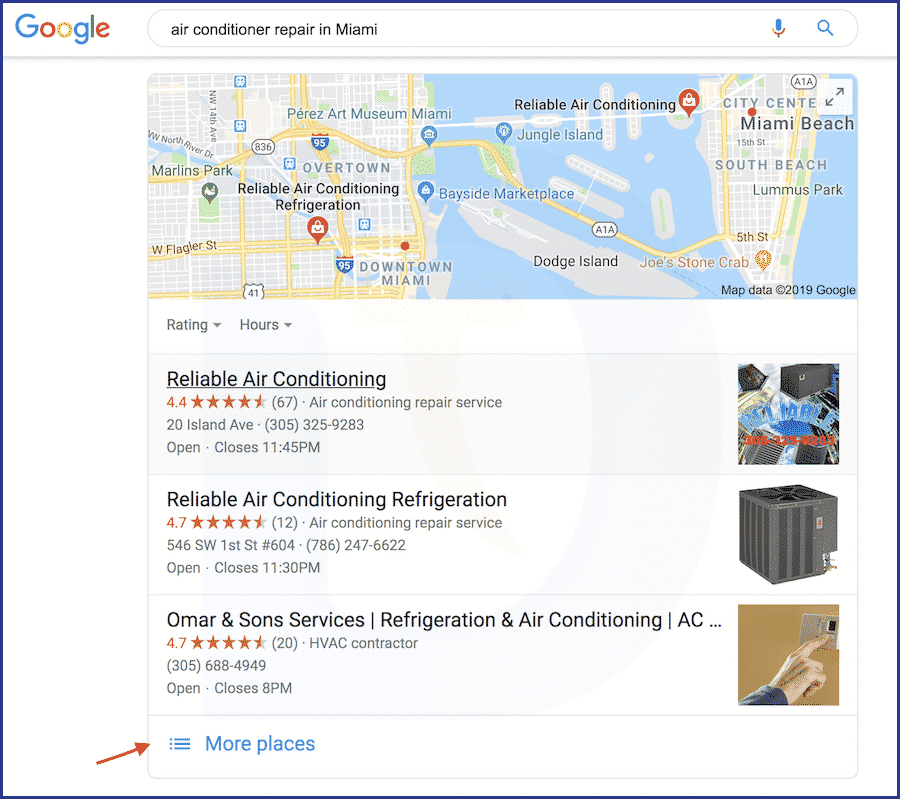
Notice the compromise Google makes to the 7-pack by allowing you to see additional results. All you have to do is click on “More places” which I marked with a red arrow.
You can also see in the local 3-pack that each of the business listings contains data for the business name, address, and phone number, the bare minimum requirement to be listed. These companies did went above and beyond by including their hours, customer reviews, and relevant business photos. More on why that’s important coming up later…
While I did cover a few of the benefits of ranking in the intro to this guide, I figure it’s important to get to the reasons to do it for your customer’s sake, so a little repetition won’t kill you.
Geolocation is all the rage these days with apps and games. Catering to your clients means it matters to rank on Maps if you want someone to find your business when they’re nearby. And besides, people are generally ready to buy when searching for local service providers “near me now”. They have a pain point they need you to solve ASAP.
When you rank at the top of Google Maps for local providers in your industry, you skyrocket your brand awareness and you’ll be more likely to get the calls or the foot traffic your after.
You want customers – this is how you get them.
Capiche? (Or is it capeesh?)
THE GOOGLE RANKING FACTORS BIBLE
You do realize, the complete list of ranking factors for Google is over 100, right? Would it surprise you to know there are 210?
Would it baffle you again if I went ahead and decided to include a handy dandy checklist of ALL of Google’s ranking factors in this guide?
(It really shouldn’t, especially since I’m all about giving you so much information to refer back to at any point in time that you need it that it just might make your head spin!)
Just so we don’t venture too far off course though, I’ll let you know Google ranking factors can basically be broken down into 9 categories. And, there is some repetition of the factors between the categories.
These categories are:
- Domain-level
- Site-level
- Page-level
- Backlink
- User interaction
- Brand signal
- On-site search spam
- Off-site search spam
- Google algorithm rules
Brain Dean over at Backlinko put together this amazing guide, if you’d like deeper explanations for each factor. Otherwise, if you just want the down and dirty checklist so you can tick off each box when you audit your own site, hit me up with your name and email address right here…
[green-download-area]FREE Bonus: Download This Checklist[/green-download-area]
A list of over 200 ranking factors can be a bit much, don’t you think? Especially since the scope of what you’re looking to do is get to the top of Google’s local search results, and fast. You can worry more about your website down the road a few ticks. Right now you just need some smiling faces coming through the door.
Now that we’ve got that clear, let’s chat a moment about Google ranking factors for local maps results. I look to Moz and Bright Local for spot on up to the minute advice on the best ways to grab local citations and garner a spot in the coveted top three.
What’s that? You’re wondering what the heck a citation is?
We will get into more detail about it coming up, In short, a citation is simply the business name, address, and phone number that shows up when a person types (or asks Alexa) for a business type in a specific location. You’ll find them in places like Google, Apple Maps, Yahoo Local, Bing Local, and Yellowbook to name just a few.
According to Moz, the most important boosts to your ranking in 2018 are all about engagement and less about getting a bazillion citations. They include:
- Proper registration with and use of Google My Business (GMB) and its features
- 100% completion of your profile on GMB – leave no profile answer blank
- Uploading photos and videos of your business regularly to GMB
- Starting your own Q&A to spark audience participation
- Use Google Posts every week (or more) with a call to action on them for your customers
- Getting reviews on Google from your clients that use keywords relevant to your business
- Personally responding to all reviews on Google
Here is a breakdown of the top needle moving local search ranking factors from the survey they recently conducted.
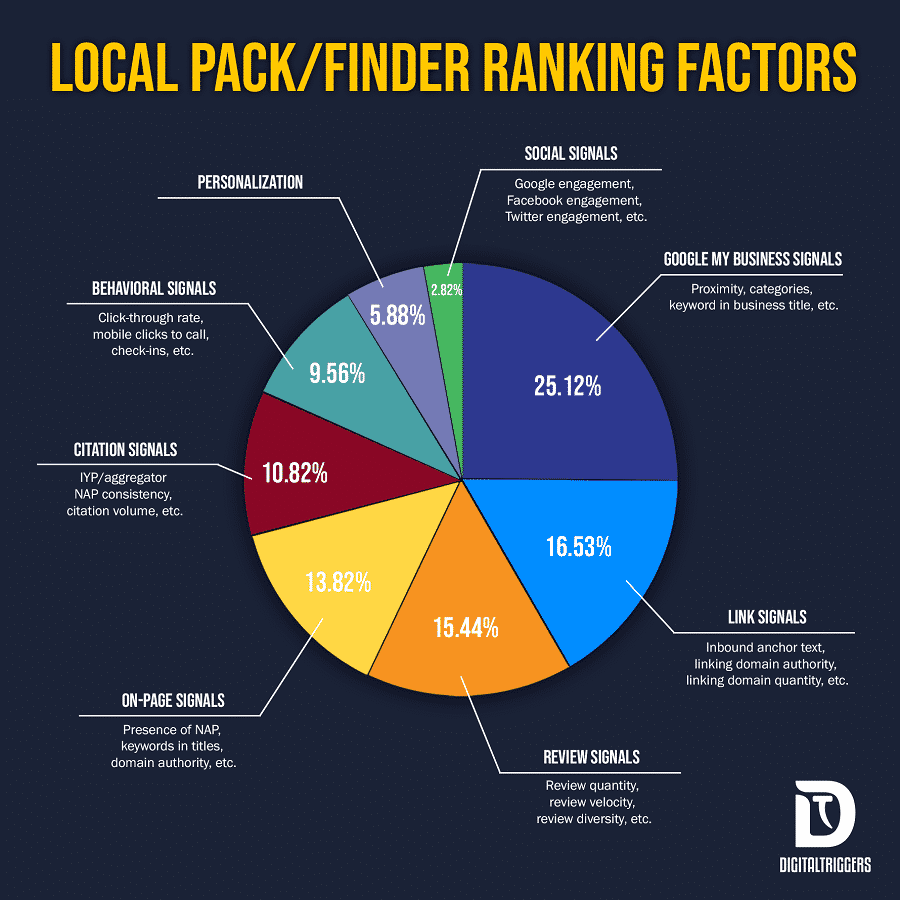
And, just in case you need a visual about the importance of the 2018 bronze winner, check out these historical stats about reviews.

Bright Local took Moz’s survey results a step further by conducting their own rank factors webinar with a panel of SEO experts. An interesting debate surfaced about spamming, aka keyword abuse, in business names, the fourth and fifth place factors from Moz’s survey. Take a tip from me. Please don’t go changing your business name to match a search query. If for no other reason, you’ll lose points in the “personalization” factor for sure.
Another key takeaway from Bright Locals meeting of the minds…Citations are cool and all, but they alone won’t get you to the top of Google’s local results now that they’ve upleveled their algorithm game. Of course, you should totally still build them first and fast. Just don’t stop there. Keep hitting on all the important factors once you have a solid amount of local citations live.
RANK HIGH, FAST, AND FOREVER (OR FOR A LONG TIME)
If you’re looking for the Cliff’s Notes version of getting ranked on Google’s local 3-pack (plus get a handy dandy bonus agency strategy when you share the post on social media), you can find it here.

But, if you’re ready to dive deeper into all the ways that help you to cumulatively win the pole position on Google Maps, keep reading.
SUBMIT THE RIGHT WAY TO GOOGLE MY BUSINESS
First thing’s first. Get on over to Google My Business and begin the process of registering your place of business.
This is the page you’ll see when you click the first result for the search “Google My Business”. Click the first green button to get started.

As I mentioned before, there’s a few highly important things to do when you set up your new GMB profile. I’ll go into a little more depth on each of these important tasks.
GMB submission walk through
Once you click the “Manage Now” button, here’s everything you’ll need to report to get your business registered on GMB. You can actually see how far you’re into the digital survey when the gray bars below the “Next” button turn blue.
First, Google wants to know the name of your business.
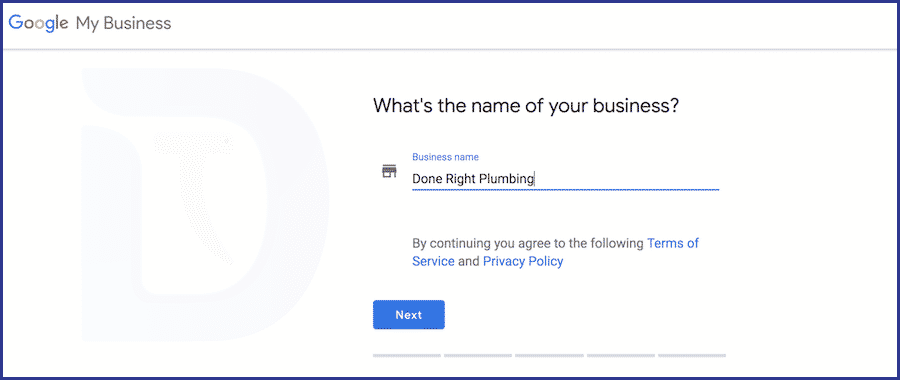
Next, you’ll be asked for your business location.
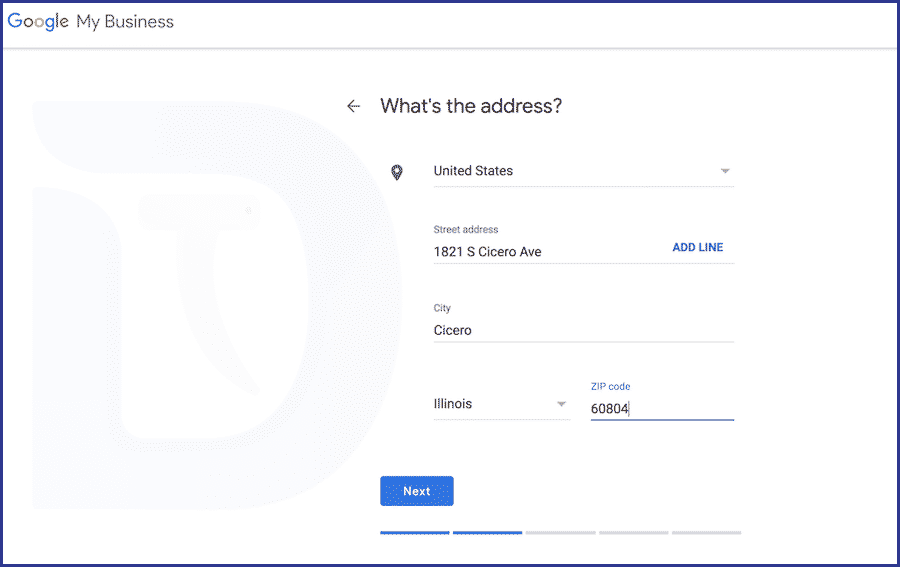
GMB will then verify if you have a store or office location people can come to.
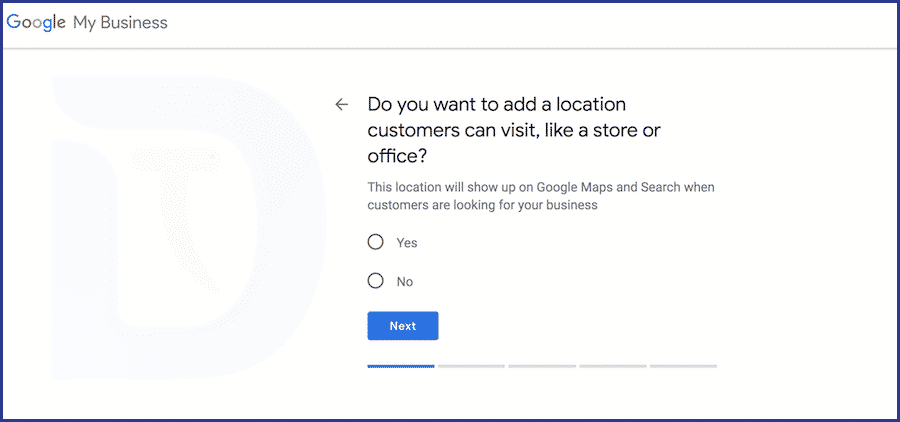
Another location question GMB wants you to answer is to verify none of the businesses they have on file with an address similar to yours is the business you’re attempting to register.
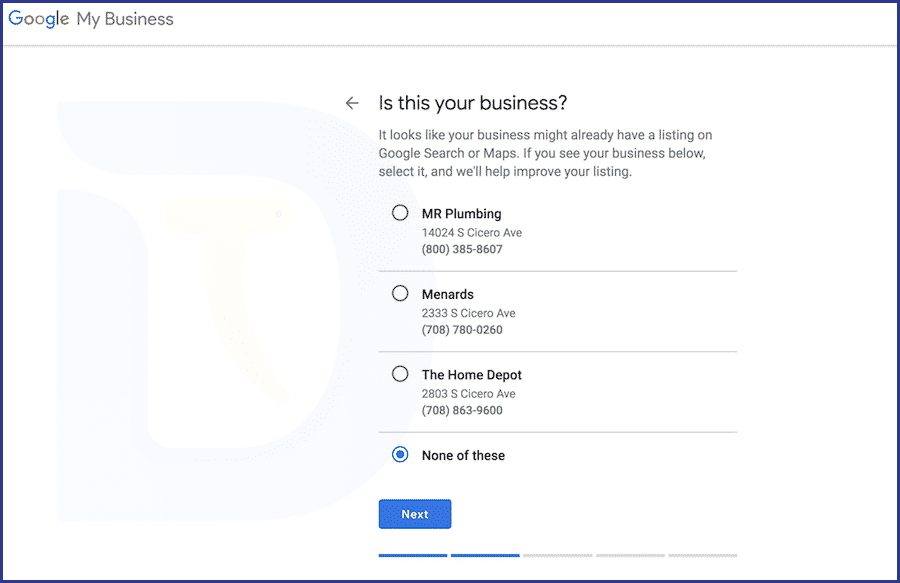
Next GMB wants to know if you provide services outside of your immediate location.
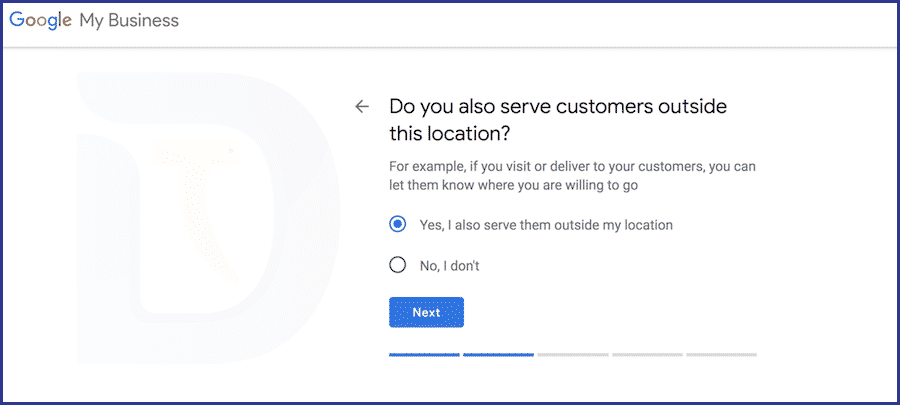
If you answer yes to the previous question, Google wants to know where else you provide your services.
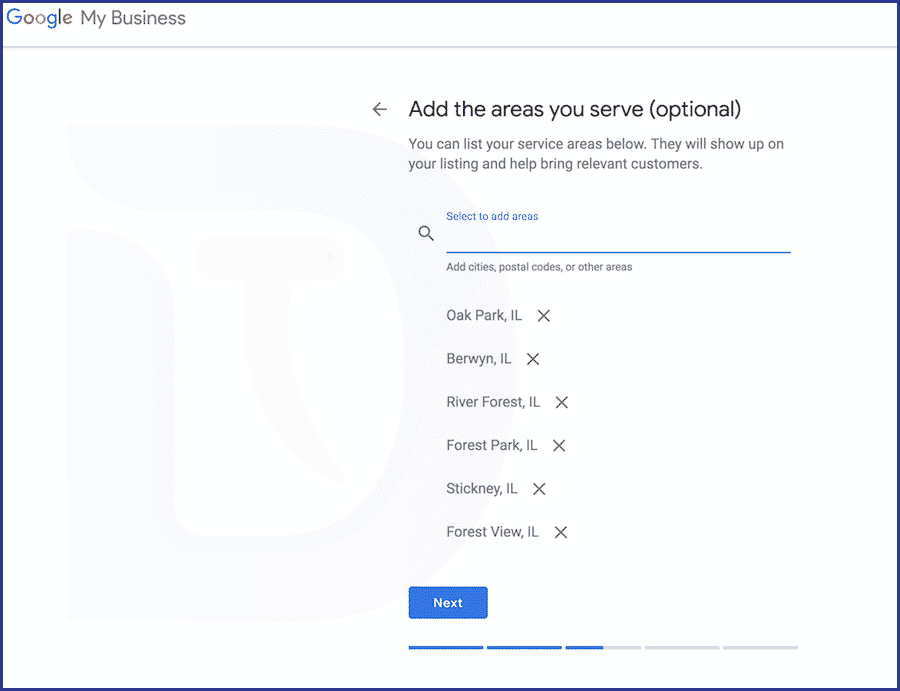
Now that all the location information is recorded, Google wants to know what industry or category your business falls into.
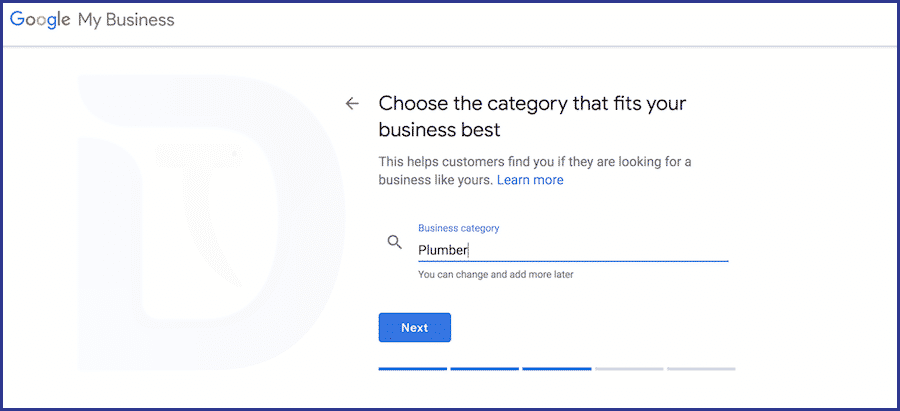
After that, comes the all important contact information details, including your phone number and your website.

If you don’t already have a website (which I highly recommend you invest in doing), you can get a free one to tide you over from GMB. I mean, if Google is going to feature your business on search results, they want you to have an online presence too.

And, for the last and final step, Google wants to verify your business. Once you push the “Next” button, you’ll get the opportunity to verify via an automated phone call. Definitely choose that option. Google can also send you a postcard by mail to verify your business.
Just know that GMB will use the information you provided to verify you. They will call you at the number you listed in your GMB profile and/or mail you your verification postcard to the business address. So make SURE it’s accurate and you didn’t fat finger anything!
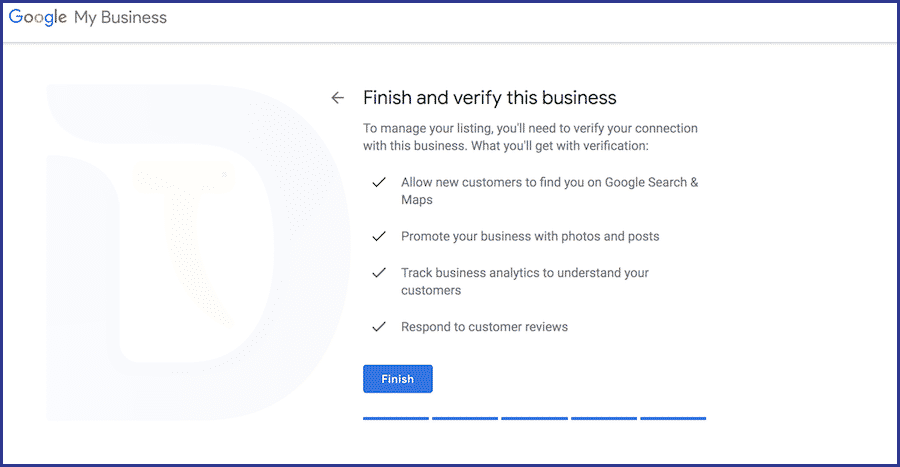
MAKE YOUR GMB PROFILE SHINE
Once you’re approved and your GMB account is active, it’s up to you to do as much as possible to optimize it. The more information and relevant content you provide in your listing that relates to your business keyword the better. Ultimately, your profile should be 100% complete.
Some key places to
Standardize your NAP
In other words, make sure your name, address, and phone number appears exactly the same on each of the local citations you reach out to get. Not just for the biggies like Google, Bing, and Apple Maps either.
Every citation. Every time. Forever.
Hours of operation
Just like the NAP, this information should be consistent across every citation you have out there in the world wide web.
This may get a little tricky if you have changes to your hours seasonally, or if you’re not keeping a spreadsheet of all your citations. So, do yourself a favor, and make it a point to track where you’re showing up and to check your citations at least on a quarterly basis for accuracy.
Get customers talking about you
And by that I mean, in a good way.
We all know bad news spreads faster than good. When a friend has a bad experience at a restaurant or a car dealership, EVERYBODY hears about it. Your mission, if you choose to accept it, (which you probably should since it’s the highest needle mover on getting top billing on Google Maps) is to get your happy customers telling Google how happy they are with you.
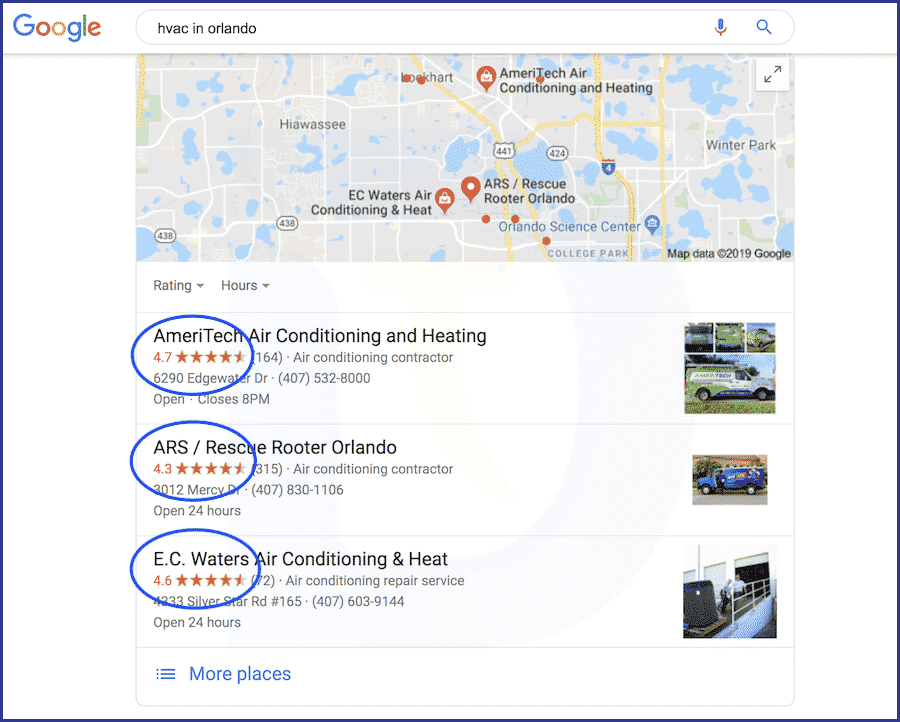
I don’t know about you, but I’m picking result one or three from these HVAC service providers to call. And, depending on what time it is and how hot I am, because of their 24-hour service, I’m likely to pick E.C. Waters as my first choice overall.
It’s time to get a system in place to get satisfied clients to complete business reviews for you on Google so you can rank as close to 5 out of 5 stars as possible. Think of what you can do to reward people for completing the review. Even something as small as a gift card to Starbucks or a great local cafe isn’t a bad idea.
Then, once you’ve got plenty of good press on GMB, you can start asking your clients to report in on other sites where you’re listed.
Make friends with Google Posts
Even if you’re not naturally a writer, be sure to get some relevant stuff posted on Posts on Google.
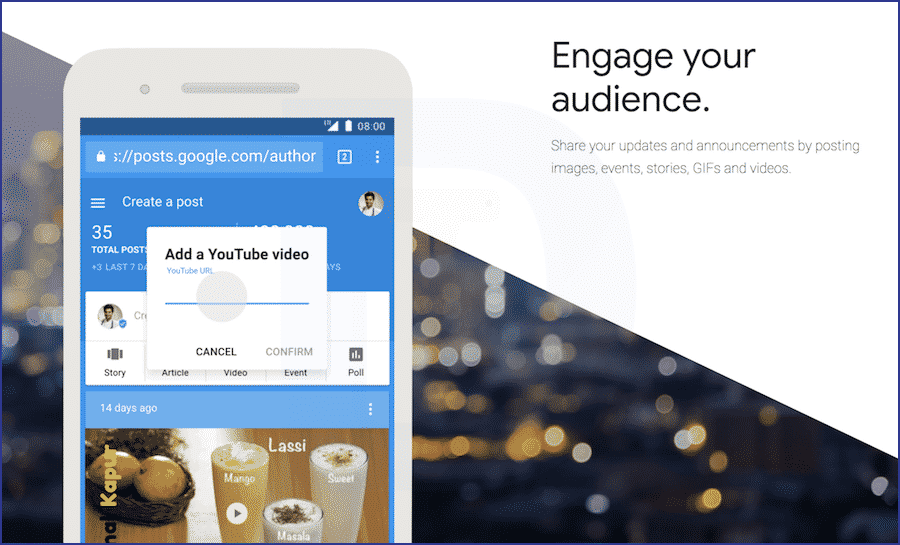
You can do something as simple as recording videos, adding before and after pictures of projects, or even sharing commercials you’ve got running on your local television stations. If you want to get super efficient, you can even alter a Facebook or Instagram post a wee bit and post it.
Two things to consider here. First, Google loves content that is recent. Google also loves content that is relevant.
So, if you make it a habit to at least share something weekly on your GMB profile that has an industry relevant keyword that people will be searching for when they’re looking for your business (high efficiency furnace for HVAC for example), you’ll be in way better shape than 99% of competing businesses in your area who aren’t doing this.
Accept the free Google website if you need it
You already know if you’re reading this that even if you only sell services and goods at a location in your area, you should still have a website. While I used to have to beat people up about this 10 years ago, almost everybody who’s in business today knows the importance of being on the internet.
Even if you’re on a tight budget, or you don’t know how to build a website, there are plenty of inexpensive alternatives to pursue to get yourself hosted online. Of course, I’m going to recommend you get some help from a website builder with a basic build that is SEO conscious (and yes, you can find someone good in the range of $300-500 if you know where to look).
That said, if you have yet to build your site because you’ve been focused on opening your physical location first, accept the free site Google is offering you at the absolute minimum. And, as you use Google Posts, you can start building up an arsenal of content your web developer can use when you’re ready to get your official website done up.
IMPORTANT “TO-DOS” FOR A WEBSITE IF YOU OWN ONE
Remember that “contact details” step I showed you earlier when registering on GMB? If you have a website already, how you provide the URL in that step? Good.
Once you enter that URL in, Google now knows where to send anyone who clicks on the website icon in the search result.

What I expect to find when I visit that website is a site that screams lawn maintenance, crabgrass treatment, fertilizing schedules and the like. Like Google, I want the first page I see to be a 100% match to what service I need. The moral of the story here is to optimize your homepage so it hits all the notes that both your customers and Google expects.
Besides SEO factors, some other factors to consider for Google favoritism when you have a website in your GMB listing follow.
Fast loading speed for your website
The longer your site takes to load, the more likely the person searching for you will pogo stick onto the next search result listing. Do everything you can to optimize your page load speeds. Several statistics have shown that websites loading in 1 second can achieve a conversation rate of up to 40%.
Mobile search prioritization
Because Google realizes the preferred way for searchers to view the web is on their mobile devices, it should matter to you too. The mobile user experience on your site is now more important than the desktop experience, so be sure you’re providing your audience a good one.
Embed Google maps and Schema on your website
Google maps is self-explanatory, but what about Schema?
Schema is a way for Google’s (and other major search engines) algorithm to understand what your site is actually about. When you use it on your website, it makes sure the “snippets” that show up below your result are relevant to the searcher’s query.
Improve your website rank on SE Ranking
SE Ranking is basically a legal industry espionage tool. You can see how your site ranks for an industry keyword along with the top five competitors in your area. Move up the rankings to get more organic (free) traffic to your site.
WINNING AT THE CITATIONS GAME
Citations are where it’s at, before any other thing, to land a top spot on local search results, aka, Google maps, in your industry. Think about it. If the big local search engines don’t know your business exists, how are you going to rank before your competitors who took the time to get their business reported?
And, while the Moz survey I referenced before may not show citations as the top way to influence Google to give you one of the the top three spots for this year, without them, you’re tanked.
Some other search engines you’ll want to get listed with at the bare minimum include Yahoo Local, Bing Local, Yelp, Yellowbook, and Apple Maps. Just remember, always use the EXACT same profile information with every single site you’re requesting a citation from. It will save you loads of time down the road trying to clear up inconsistencies
Use this handy dandy infographic of the best places Moz recommends to get your business citations and you can’t go wrong.
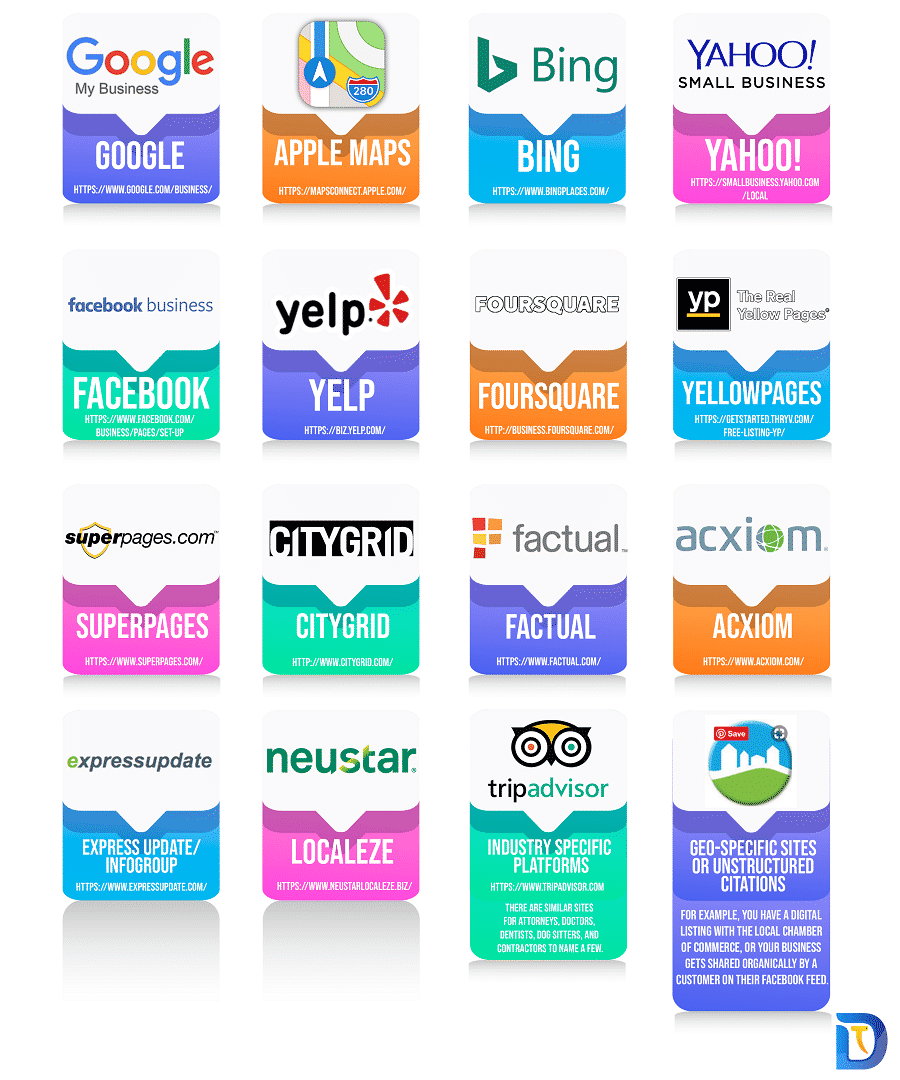
Aim for authority citations
What exactly is an authority citation anyway? I mean, I’ve already told you being on GMB is the ultimate authority, so what else is there?
Your GMB listing is just the tip of the iceberg. Google knows its own importance when it comes to ranking your business, but it also needs to know your business is ranking in other important places on the internet. Authority citations that help boost your business relevance include listings in your local city or county directories.
Authority also comes from being listed in niche specific local directories. So, if your city has a directory of all the local restaurants in the area and you own one yourself, do whatever you can to be listed on it.
To unlock my secret sauce on how to get authority citations, watch and share this short video I created.
BONUS: Getting local citations for clients as an agency
So you like the idea of getting local businesses known on the internet so much that you want to help them do it, huh? (Feel free to breeze over this section if you’re only interested in getting citations for yourself.)
If you answered yes, take a few pointers from me on how to do it. I’ve been doing it for over a decade now, so use my shortcuts. If I didn’t want you to, I wouldn’t be sharing them here.
When you’re ready to get your clients listed, you’ll want to use a few awesome tools to make your life a little easier.
Start by using Yext to control the information going out about your client to hundreds of digital listing sites.
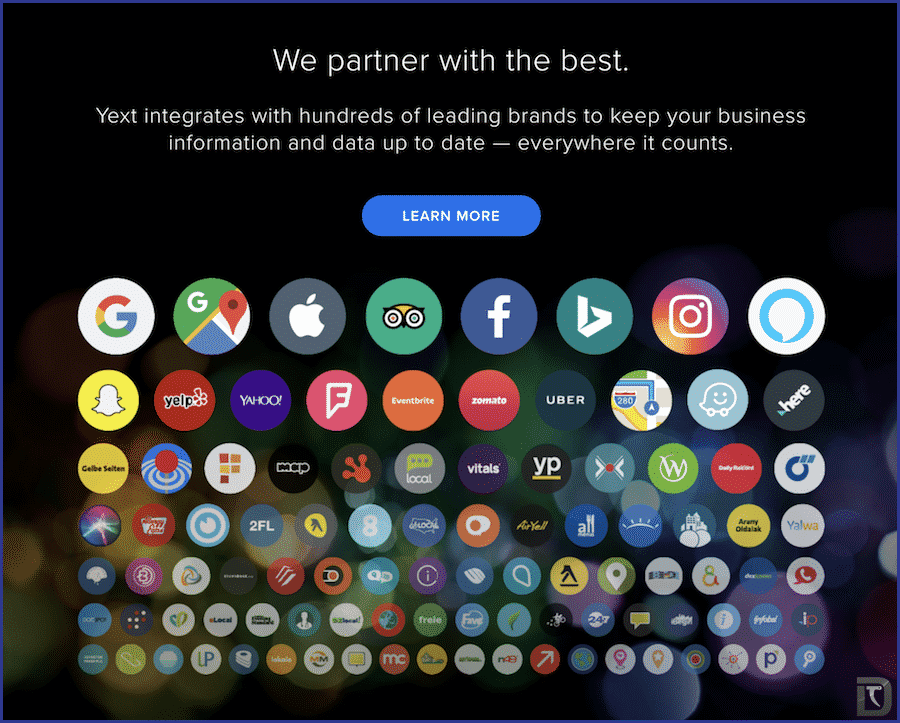
Yext is what you would call a data aggregator, a company who is in the business of compiling all the factual data about your business to distribute to listing sites across the web. Other well known data aggregator platforms include Acxiom, Factual, Localeze, and Express Update.
Build the cost of using a data aggregator into your agency fees for each client. Let the tools do the hard work of keeping citations tracked and up to date while you deliver the total marketing package to your client.
Other providers you can choose like Yext include Whitespark, Brightlocal and Moz Local. It’s simply a matter of your preference which data aggregator you’d like to team up with for your client database. There are variations in cost and time it will take them to get you citations back, so keep that in mind when you choose which service you want to partner with too.
I share my favorite “go to” data aggregator to partner with in the video I mentioned in the last section. Be sure to check out WL Marketing. For the money and turn time, it’s a no-brainer to choose them to build your clients’ citations.
Just a couple of tips for you if you decide to add this to your marketing agency offerings. A tech savvy client can do a search for these companies and partner with them directly, cutting you out as the “middle man” providing them this service.
That said, be sure not to mark this service up too much (if at all), and don’t lead with this as the only service you provide your client. It should be part of a package deal you create specific to their needs.
You’ll want to frame citation getting as a lead generation service for your clients. Provide them with stats for how many call ins you’ve gotten them since building their citation network by using a tool like Analytic Call Tracking. This tool will allow you to create reports for your clients and can also help you determine what “per lead” fee to charge the customer to manage their Google Maps listing.
FIND TIME TO GET SOCIAL
…At least digitally anyway. I know you don’t live under a rock. You realize that almost everybody buries their face in their phones on the regular to scroll through their social media feeds.
Facebook.
Instagram.
Snapchat.
YouTube.
Twitter.
Pinterest.
LinkedIn.
These are all popular choices in the United States anyway. While all of these platforms may not be right for your business, I can say without a doubt that Facebook, Instagram, LinkedIn, Twitter, and YouTube are all contenders to consider.
Why?
Well, Google shows you ranking love when your business is represented on Facebook, Twitter and LinkedIn. And, every platform on this list are all places you can run paid ads if you decide you want to do that in the near future.
Plus, it’s incredibly easy to share social media posts about your business on social media platforms. More shares there equal more live links to your business. Google likes it when your business is referenced on multiple sites on the web. Backlinks prove your validity, and these are the kind you don’t have to ask anybody to give you since you own the social media pages.
Positive link velocity matters too, so if you’re lucky enough to have satisfied customers sharing your social posts, that’s not going to hurt you in Google’s eyes either.
GOOGLE ADS-THE 900 POUND GORILLA IN THE ROOM
All this talk about how to get in the top three on Google Maps search results, and no mention of getting paid ads yet? Well, I was trying to help you out with free things you could do first. And, I wanted you to get all the groundwork done before spending any money.
But, since you’ve made it here, and you’ve been diligent about completing all the other steps, it’s time to consider how to pay to get to the top of Google results.
When you do a search on Google for a local dentist, for example, what shows up first?
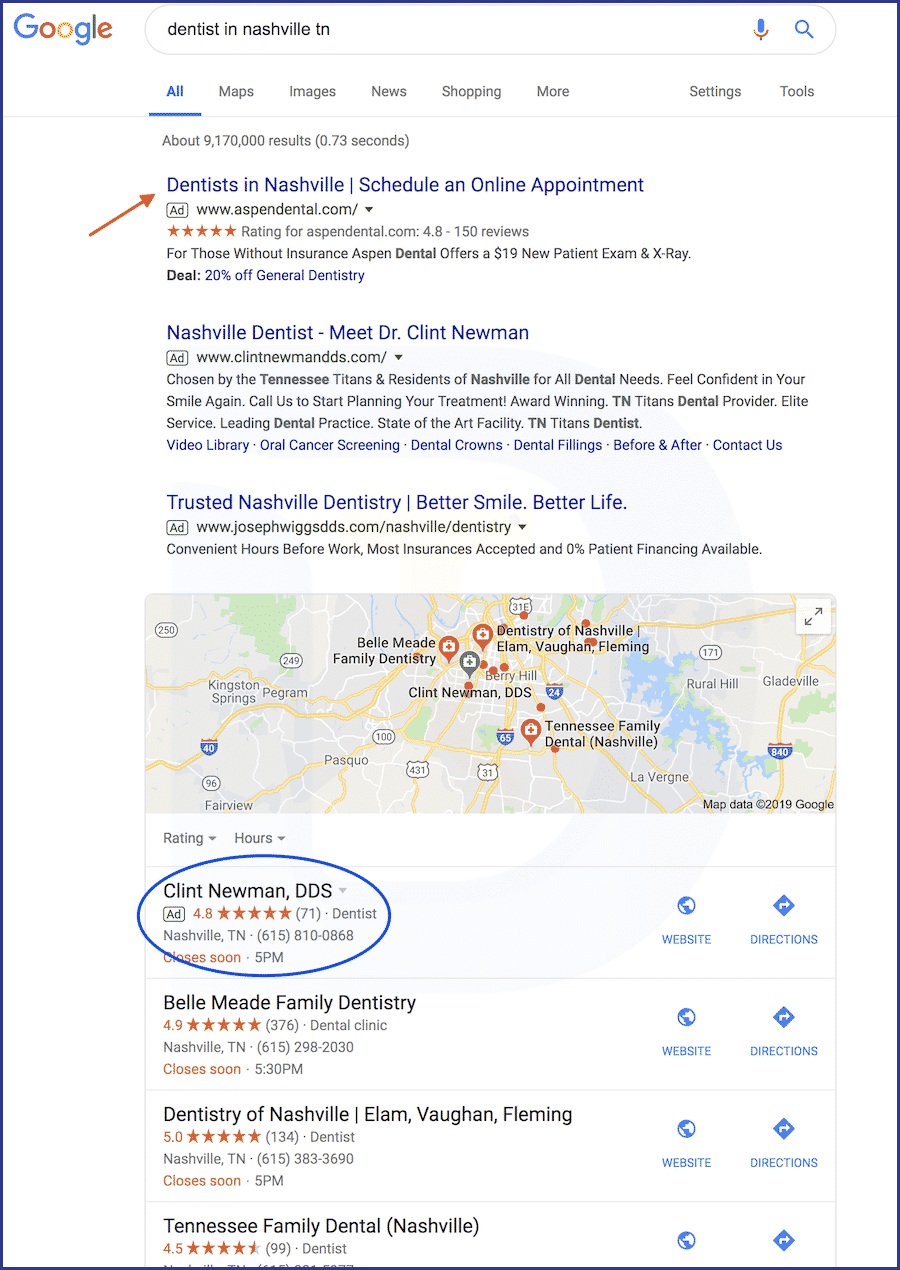
Notice, the paid ad shows at the very top of the results above the Google Maps results. Additionally, did you catch how the 3-pack became a 4-pack, and Clint Newman has the top listing in the Maps results?
Yes, there’s an “ad” tag in front of his ratings to show Dr. Newman paid for the top spot, but does it change your decision to click through in any way? My marketing brain would be like, this guy’s a genius.
Understanding what your local competition is doing on their Google My Business profile can give you an edge. Having the right Google Maps scraper solution allows you to export search results efficiently and helps optimize your strategies.
Dr. Newman wanted first ranking and bought it, so he knows the value of being top dog. He has a little money to pay for ads, so that’s a plus. His review ratings are good but since he’s got less of them than the dentists in the 2-4 spots, he may have a newer practice, and taking over the doctors who were ahead of him may have taken some time.
All signs would point me to tell my own agency client to buy an ad if they were in a spot like Dr. Newman was. If it makes positioning and financial sense for you to place a local ad, you should consider it too. Remember, in Google’s eyes second place is the first loser.
Remember three things if you decide to place an ad for your business.
First, make sure you use relevant keyword targeting.
Second, choose the location in which you want the ad to run. You only want the people that live in your area and do a “near me” search, or search your area to see your ad and click through to your business.
Finally, be sure to enable local extensions inside your GoogleAds account dashboard. This will allow people to see your business address and distance from their location.
HOW TO MASTERMIND YOUR GOOGLE MAP SEARCH RESULTS
I realize, this guide has a ton of information to take in. To earn a top three rank for your local business on Google, there’s a lot of moving parts.
First, comes registering your business right with the major player in charge of your “maps” destiny, Google My Business. But, registration alone won’t do it. You’ve got to get your profile singing your benefits to the people out there searching for your solutions.
Then, you have to build up a good sized citation network, and that can take serious time and dedication without the proper tool. It can definitely make you cross-eyed if you choose to go it alone without the help of a data aggregator.
After that you’ve got to get relevant content out there, and make sure to get it shared in as many places as possible on the internet. You also may want to consider “buying into” the top spot, depending on your local competitors’ ranking factors for your industry.
While I’m sharing all the relevant ways you can use to get to the top of Google Maps, as with anything in the digital world, those factors change regularly. That’s why I decided to put together a place you can come to stay current on all the winning strategies you can use to dominate online. I call it the Digital Triggers Mastermind, and it is open for enrollment now.
Inside, you’ll get direct one-on-one access to me, your partner in crime (really, your accountability buddy). You’ll learn in-depth marketing strategies that are crushing it in the present day. No dusty old stuff that’s not worth your limited time. Real time feedback from me inside a private space so you can execute the right steps at the right time to win both at your storefront and online.
If you’re a wanna be marketing nerd, the Mastermind is for you. Or, if you have someone on your staff who you pay hourly to do your marketing (like your social media posts and such), you can always enroll them in the Mastermind. In fact, that’s exactly the play I suggest you make so you can keep your head in the game for servicing your customers best.
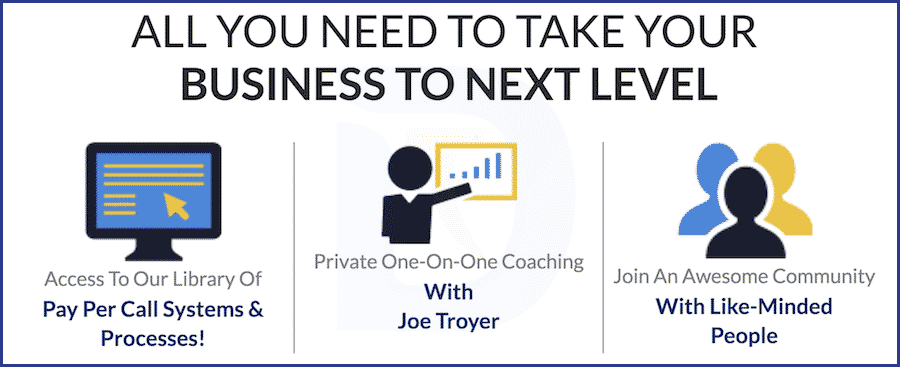
ACTION STEPS TO HIGHER RANKINGS ON GOOGLE MAPS
I just shared every important action step you can take to earn yourself a spot in the Google Map 3-pack for your local business. Here’s what you need to put on your to-do list:
- Pay special attention to and buy into current trends with Google’s local ranking factors
- Submit your business listing to Google My Business
- Make the most complete GMB profile possible by including office hours, getting customer reviews, and submitting videos, photos, and articles on Google Posts
- Optimize the home page of your business website or accepting the free GMB website
- Get your business citation network built with all the major search engines, along with as many of the hundreds of other online directories as possible
- Earn authority citations by getting featured in local and niche directories
- OPTIONAL: Consider investing in a data aggregator service to save you time and get your business accurately listed in hundreds of online directories
- Use social media to promote your business and build relevance in multiple places on the web for your industry keywords
- If you can’t hit the top three on Google Map results after using the organic methods presented, consider investing in Google ads to make the list
- OPTIONAL: Improve your marketing results when you enroll an hourly employee in the Digital Triggers Mastermind and they execute the newest and most effective marketing strategies that they learn inside for your business
Now that you’re armed with the next best actions to take, go be dangerous out there. Play big, be seen, and get more folks through your doors or dialing your office.

